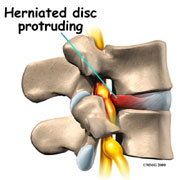A herniated disc occurs when the outer part of the donut-shaped disc between the vertebrae weakens and the inner part (a gel-like substance) protrudes outward, something like when a balloon squeezed from one side.
 Typically, people don’t feel any pain until and unless this protrusion touches a nerve.
Typically, people don’t feel any pain until and unless this protrusion touches a nerve.
Many people live out their lives with one or more herniated discs and never know it.
If the protrusion does touch or compress a nerve, it usually causes pain in the lower back, radiating down the back of one or both legs and sometimes causing sharp, needling pain in the bottoms of the feet.
If the herniated disc is higher up the spine, radiating pain can occur in the arms.
The primary cause of a herniated disc is the excessive compression and torsion that is placed on the spine, which is the result of numerous muscle imbalances throughout the body.
In addition, two often overlooked yet major factors are dietary imbalances and negative stress and/or emotions.
Herniated disc disease also is referred to as bulging disc, ruptured disc, slipped disc, prolapsed disc, or degenerative disc disease.
Because a herniated disc is a complicated condition, it may require several types of treatment approaches.
For example, while inversion therapy can provide some relief, better results are often found when inversion therapy is joined by Muscle Balance Therapy.
Controlling stress and inflammation is highly suggested in any herniated disc treatment.
Strongly consider changing your diet, including healthier foods, and drinking plenty of clean water, Proteolytic enzyme therapy and daily self-administered trigger point therapy have also provided relief for many.
Far-infrared heat is another treatment that deeply penetrates the area, bringing relief, as well as improved blood flow for faster healing.
 This condition specifically responds well to spinal decompression and inversion therapy, both of which reduce the pressure on the surrounding nerves, while increasing range of motion and improving circulation to the afflicted area.
This condition specifically responds well to spinal decompression and inversion therapy, both of which reduce the pressure on the surrounding nerves, while increasing range of motion and improving circulation to the afflicted area.
With a herniated disc, getting pressure off the spine is critical to recovery, and turning the body upside down is the best way to do that.
Reverse gravity opens the spaces between the vertebrae, giving them room to heal and encouraging them to slide back into place.
If you have this condition, invest in a quality inversion table immediately and begin using it as soon as you can.
Temporary Pain Relief — Action Plan
Read about all the elements of a successful temporary pain relief action plan
These are the three you should begin today, in order of importance
-
Far infrared heat therapy
-
Pain-relief cream
-
Natural anti-inflammatory (e.g., proteolytic enzyme supplements)


Thanks a lot for all your help.